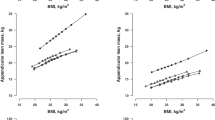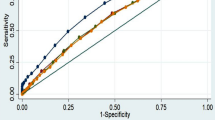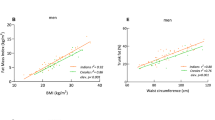Abstract
OBJECTIVES:
To examine differences in the relationship between fat distribution and lipid coronary risk factors in Caucasian and Japanese population and further to determine whether the cut-points for body mass index (BMI) and waist circumference (WC) proposed by WHO and NHLBI are applicable to Japanese population as a predictor of a lipid risk factor abnormality or not.
RESEARCH METHODS AND PROCEDURES:
Subjects were 895 participants of the Baltimore Longitudinal Study of Aging in the US (BLSA) and 1705 participants of the Longitudinal Study of Aging by the National Institutes for Longevity Science in Japan (NILS-LSA). Subjects were divided into four demographic groups as younger (age<65 y) men and women, and older (age≥65 y) men and women. Blood total cholesterol, triglycerides, LDL- and HDL-cholesterol and anthropometry were measured. Regression coefficients of BMI and WC on risk factors, sensitivity and specificity of the BMI and WC cut-points for blood lipid abnormality, and mean values of blood lipids at BMI or WC cut-points were computed in both populations.
RESULTS:
Height, weight, WC and BMI were significantly greater in the BLSA than those in the NILS-LSA subjects. Total cholesterol, HDL- and LDL-cholesterol were significantly greater in the NILS-LSA than in the BLSA subjects. Sensitivities of BMI and WC cut-points were much lower in the NILS-LSA than in the BLSA subjects. Specificities of BMI and WC cut-points were higher in the NILS-LSA than in the BLSA subjects. Mean values of triglycerides, total cholesterol, HDL- and LDL-cholesterol at BMI=25 were significantly greater in the NILS-LSA than in the BLSA subjects. At the WC cut-point (94 cm for men, 80 cm for women), mean values of all lipids were significantly greater in the NILS-LSA than in the BLSA subjects with the exception of triglycerides in younger women.
CONCLUSIONS:
The Japanese subjects have smaller BMI and WC, worse total and LDL-cholesterol levels and better HDL-cholesterol levels compared to Caucasians. Sensitivities of BMI and WC for predicting lipid risk factor abnormality are much lower in Japanese. The cut-points for BMI and WC proposed by WHO and NHLBI may be too high for predicting an abnormality in triglycerides, total and LDL-cholesterol in Japanese. For detecting an abnormal HDL-cholesterol level, the BMI and WC cut-points may not be as beneficial for the Japanese population as for Caucasians.
This is a preview of subscription content, access via your institution
Access options
Subscribe to this journal
Receive 12 print issues and online access
$259.00 per year
only $21.58 per issue
Buy this article
- Purchase on Springer Link
- Instant access to full article PDF
Prices may be subject to local taxes which are calculated during checkout
Similar content being viewed by others
References
National Cholesterol Education Program. Third report of the National Cholesterol Education Program (NCEP) Expert Panel on detection, evaluation, and treatment of high blood cholesterol in adults (Adult Treatment Panel III) final report. Circulation 2002; 106: 3143–3421.
Fujioka S, Matsuzawa Y, Tokunaga K, Tarui S . Contribution of intra-abdominal fat accumulation to the impairment of glucose and lipid metabolism in human obesity. Metabolism 1987; 36: 54–59.
Bjorntorp P . Metabolic implications of body fat distribution. Diabetes Care 1991; 14: 1132–1143.
Bjorntorp P . Abdominal fat distribution and disease: an overview of epidemiological data. Ann Med 1992; 24: 15–18.
NHLBI Obesity Education Initiative Expert Panel. Clinical guidelines on the identification, evaluation, and treatment of overweight and obesity in adults. Obes Res 1998; 6: 51S–209S.
WHO Consultation on Obesity. Obesity. In: WHO (ed). Preventing and managing the global epidemic. Division of Noncommunicable Diseases, Programme of Nutrition, Family and Reproductive Health, World Health Organization: Geneva, Switzerland; 1998.
Molarius A, Seidell J . Selection of anthropometric indicators for classification of abdominal fatness—a critical review. Int J Obes Relat Metab Disord 1998; 22: 719–727.
Pouliot M, Despres J, Lemieux S, Moorjani S, Bouchard C, Tremblar A, Nadeau A, Lupien P . Waist circumference and abdominal sagittal diameter: best simple anthropometric indexes of abdominal visceral adipose tissue accumulation and related cardiovascular risk in men and women. Am J Cardiol 1994; 73: 460–467.
Turcato E, Bosello O, Harris T, Zoico E, Bissoli L, Fracassi E, Zamboni M . Waist circumference and abdominal sagittal diameter as surrogates of body fat distribution in the elderly: their relation with cardiovascular risk factors. Int J Obes Relat Metab Disord 2000; 24: 1005–1010.
Lean M, Han T, Seidell J . Impairment of health and quality of life in people with large waist circumference. Lancet 1998; 351: 853–856.
VanItallie T . Waist circumference: a useful index in clinical care and health promotion. Nutr Rev 1998; 56: 300–313.
Han T, McNeill G, Seidell J, Lean M . Predicting intra-abdominal fatness from anthropometric measures: the influence of stature. Int J Obes Relat Metab Disord 1997; 21: 587–593.
Molarius A, Seidell J, Sans S, Tuomilehto J, Knulasmaa K . Varying sensitivity of waist action Levels to identify subjects with overweight or obesity in 19 populations of the WHO MONICA project. J Clin Epidemiol 1999; 52: 1213–1224.
Hu F, Wang B, Chen C, Jin Y, Yang J, Stampfer M, Xu X . Body mass index and cardiovascular risk factors in a rural Chinese population. Am J Epidemiol 2000; 151: 88–97.
Iwao S, Iwao N, Muller D, Elahi D, Shimokata H, Andres R . Effects of aging on the relationship between multiple risk factors and waist circumference. J Am Geriatr Soc 2000; 48: 788–794.
Iwao N, Iwao S, Muller D, Elahi D, Shimokata H, Andres R . A test of recently proposed BMI standards with respect to old age. Aging: Clin Exp Res J 2000; 12: 461–469.
Shock N, Greulich R, Andres R, Arenberg D, COsta PJ, Lakatta E, Tobin J . Normal human aging. U.S. Department of Health and Human Services, U.S. Government Printing Office, National Institutes of Health Publication: Washington, DC, 1984. pp 84–2450.
Shimokata H, Ando F, Niino N . A new comprehensive study on aging—the National Institute for Longevity Sciences, Longitudinal Study of Aging (NILS-LSA). J Epidemiol 2000; 10: S1–S9.
Warnick G, Benderson J, Albers J . Dextran sufate-Mg2+ precipitation procedure for quantification of high-density-lipoprotein cholesterol. Clin Chem 1982; 28: 1379–1388.
Friedewald W, Levy R, Fredrickson D . Estimation of the concentration of low-density-lipoprotein cholesterol in plasma without the use of the preparation ultracentrifuge. Clin Chem 1972; 18: 499–502.
National Cholesterol Education Program. Second report of the expert panel on detection, evaluation, and treatment of high blood cholesterol in adults. Circulation 1994; 89: 1333–1432.
Molarius A, Seidell J, Sans S, Tuomilehto J, Kuulasmaa K . Waist and hip circumferences, and waist–hip ratio in 19 polulations of the WHO MONICA Project. Int J Obes Relat Metab Disord 1999; 23: 116–125.
Brown C, Higgins M, Donato K, Rohde F, Garrison R, Obarzanek E, Ernst N, Horan M . Body mass index and the prevalence of hypertension and dyslipidemia. Obes Res 2000; 8: 605–619.
The Ministry of Health and Welfare. National nutrition in 1998. Daiichi Public: Tokyo, 1999 (in Japanese).
Nakamura T, Tokunaga K, Shimomura I, Nishida M, Yoshida S, Kotani K, Islam A, Keno Y, Kobatake T, Nagay Y, Fujioka S, Tarui S, Matsuzawa Y . Contribution of visceral fat accumulation to the development of coronary artery disease in non-obese men. Atherosclerosis 1994; 107: 239–246.
Despres J . Abdominal obesity as important component of insulin-resistance syndrome. Nutrition 1993; 9: 452–459.
Takami R, Takeda N, Hayashi M, Sasaki A, Kawachi S, Yoshino K, Takami K, Nakashima K, Akai A, Yamakita N, Yasuda K . Body fatness and fat distribution as predictors of metabolic abnormalities and early carotid atherosclerosis. Diabetes Care 2001; 24: 1248–1252.
Kumagi S, Tanaka H, Kitajima H, Kono S, Ogawa K, Yamauchi M, Morita N, Inoue M, Shindo M . Relationships of lipid and gluose metabolism with waist–hip ratio and physical fitness in obese men. Int J Obes Relat Metab Disord 1993; 17: 437–440.
Rodriguez B, Sharp D, Abbott R, Burchfiel C, Masaki K, Chyou P, Huang B, Yano K, Curb J . Fish intake may limit the increase in risk of coronary heart disease morbidity and mortality among heavy smokers. The Honolulu Heart Program. Circulation 1996; 94: 952–956.
Nakamura K, Shimai S, Kikuchi S, Tanaka M . Correlation between a liking for fat-rich foods and body fatness in adult Japanese: a gender difference. Appetite 2001; 36: 1–7.
Pott J, Simmons D . Sex and ethnic group differences in fat distribution in young United Kingdom South Asians and Europids. J Clin Epidemiol 1994; 47: 837–841.
The Research Group on Serum Lipid Survey. Analysis of serum lipid levels in Japanese men and women according to body mass index. Increase in risk of atherosclerosis in postmenopausal women. Atherosclerosis 1999; 143: 55–73.
Iwao S, Iwao N, Muller D, Elahi D, Shimokata H, Andres R . Does waist circumference add to the predictive power of the body mass index for coronary risk? Obes Res 2001; 9: 658–695.
Acknowledgements
We thank Research Fellowships for Japanese Biomedical and Behavioral Researchers at NIH funded by the Japan Society for the Promotion of Science (JSPS).
Author information
Authors and Affiliations
Corresponding author
Additional information
Funding Source: Intramural Research Program, National Institute on Aging.
Presented in part at the Annual Meetings of the World Congress of Gerontology, 2001.
Rights and permissions
About this article
Cite this article
Iwao, N., Iwao, S., Muller, D. et al. Differences in the relationship between lipid CHD risk factors and body composition in Caucasians and Japanese. Int J Obes 29, 228–235 (2005). https://doi.org/10.1038/sj.ijo.0802615
Received:
Accepted:
Published:
Issue Date:
DOI: https://doi.org/10.1038/sj.ijo.0802615
Keywords
This article is cited by
-
Relationship between BMI and body fatness in three European countries
European Journal of Clinical Nutrition (2013)
-
Which Obesity Indicators Are Better Predictors of Metabolic Risk?: Healthy Twin Study
Obesity (2008)
-
Lower HDL-cholesterol among healthy middle-aged Japanese-Brazilians in São Paulo compared to Natives and Japanese-Brazilians in Japan
European Journal of Epidemiology (2007)



